Does the Soil Tillage Affect the Quality of the Peanut Picker?
Abstract
1. Introduction
2. Materials and Methods
2.1. Description of the Experimental Area
2.2. Equipment and Operations Performed
2.3. Experimental Design
2.4. Quality Indicator
2.5. Statistical Analysis
3. Results
3.1. Descriptive Statistics
3.2. Statistical Quality Control
3.2.1. Run Charts
3.2.2. Individual Value Control Charts
4. Discussion
5. Conclusions
Author Contributions
Funding
Data Availability Statement
Acknowledgments
Conflicts of Interest
References
- Santos, R.F.; Todeschini, A.; Rosa, H.A.; Chaves, L.I.; Bassegio, D.; Veloso, G. Evolução e perspectiva da cultura do amendoim para biocombustível no Brasil. Acta Iguazu 2012, 1, 20–35. [Google Scholar]
- Santos, R.C.; Freire, R.M.M.; Lima, L.M. O Agronegócio do Amendoim no Brasil, 2nd ed.; Embrapa: Brasília, DF, Brazil, 2013. [Google Scholar]
- USDA, United States Department of Agriculture. World Agricultural: Production: Peanut Area, Yield, and Production. 2020. Available online: https://apps.fas.usda.gov/psdonline/circulars/production.pdf (accessed on 9 August 2020).
- Conab, Companhia Nacional de Abastecimento. Acompanhamento da Safra Brasileira. 2021. Available online: https://www.conab.gov.br/info-agro/safras (accessed on 10 November 2020).
- Fachin, G.M.; Duarte Júnior, J.B.; Glier, C.A.D.S.; Mrozinski, C.R.; Costa, A.C.; Guimarães, V.F. Agronomic characteristics of six peanut cultivars grown in conventional and no-tillage system. Rev. Bras. Eng. Agríc. Ambient. 2014, 18, 165–172. [Google Scholar] [CrossRef]
- Ormond, A.T.S.; Santos, A.F.; Alcantara, A.S.; Zerbato, C.; Furlani, C.E.A. Tillage interference in the quality of peanut mechanized harvest. Eng. Agríc. 2018, 38, 251–259. [Google Scholar] [CrossRef]
- Souza, G.S.D.; Souza, Z.M.D.; Cooper, M.; Tormena, C.A. Controlled traffic and soil physical quality of an Oxisol under sugarcane cultivation. Sci. Agric. 2015, 72, 270–277. [Google Scholar] [CrossRef]
- Gírio, L.A.S.; Silva, R.P.; Menezes, P.C.; Carneiro, F.M.; Zerbato, C.; Ormond, A.T.S. Quality of multi-row harvesting in sugarcane plantations established from pre-sprouted seedlings and billets. Ind. Crops Prod. 2019, 142, 111831. [Google Scholar] [CrossRef]
- Haro, R.J.; Dardanelli, J.L.; Otegui, M.E.; Collino, D.J. Seed yield determination of peanut crops under water deficit: Soil strength effects on pod set, the source-sink ratio and radiation use efficiency. Field Crops Res. 2008, 109, 24–33. [Google Scholar] [CrossRef]
- Yang, D.; Liu, Y.; Wang, Y.; Gao, F.; Zhao, J.; Li, Y.; Li, X. Effects of soil tillage, management practices, and mulching film application on soil health and peanut yield in a continuous cropping system. Front. Microbiol. 2020, 11, 570924. [Google Scholar] [CrossRef]
- Carvalho, T.L.; Rocha, A.C.; Campos, B.F.J.; Cunha, F.N.; Silva, N.F.; Teixeira, M.B. Genótipos de amendoim cultivados em semeadura direta e convencional sob regime hídrico do sudoeste goiano. Rev. Bras. Agric. Irrig. 2014, 8, 432–443. [Google Scholar] [CrossRef]
- Molina, W.F., Jr. Comportamento Mecânico do Solo em Operações Sgrícolas; ESALQ/USP: Piracicaba, SP, Brasil, 2017. [Google Scholar] [CrossRef]
- Brandenburg, R.L.; Herbert Júnior, D.A.; Sullivan, G.A.; Naderman, G.C.; Wright, S.F. The Impact of Tillage Practices on Thrips Injury of Peanut in North Carolina and Virginia. Peanut Sci. 1998, 25, 27–31. [Google Scholar] [CrossRef]
- Sorensen, R.B.; Brenneman, T.B.; Lamb, M.C. Peanut yield response to conservation tillage, winter cover crop, peanut cultivar, and fungicide applications. Peanut Sci. 2010, 37, 44–51. [Google Scholar] [CrossRef]
- Jackson, J.L.; Beasley Júnior, J.P.; Tubbs, R.S.; Lee, R.D.; Grey, T.L. Fall-Bedding for Reduced Digging Losses and Improved Yield in StripTill Peanut. Peanut Sci. 2011, 38, 31–40. [Google Scholar] [CrossRef]
- Truman, C.C.; Potter, T.L.; Nuti, R.C. Quantifying variable rainfall intensity events on seasonal runoff and sediment losses from strip and conventionally tilled peanuts. Peanut Sci. 2012, 39, 62–68. [Google Scholar] [CrossRef]
- Shen, P.; Wu, Z.; Wang, C.; Luo, S.; Zheng, Y.; Yu, T.; Sun, X.; Sun, X.; Wang, C.; He, X. Contributions of rational soil tillage to compaction stress in main peanut producing areas of China. Sci. Rep. 2016, 6, 38629. [Google Scholar] [CrossRef]
- Huang, S.; Lin, W.; Chuan, Y.; QianRu, H.; YanHong, C.; Kun, Z.; ChangQiang, W.; QiNa, Z.; XiaoHua, Y.; YiJun, Z. Efeitos da profundidade do preparo do solo no crescimento da raiz e na atividade do amendoim em campo com declive de solo vermelho. Acta Agric. Jiangxi 2018, 30, 9–12. [Google Scholar]
- Wang, Y.; Fan, J.; Cao, L.; Zheng, X.; Ren, P.; Zhao, S. The influence of tillage practices on soil detachment in the red soil region of China. Catena 2018, 165, 272–278. [Google Scholar] [CrossRef]
- Shen, P.; Wang, C.; Wu, Z.; Wang, C.; Zhao, H.; Shan, S.; Wu, M.; Sun, X.; Yu, T.; Zheng, Y.; et al. Peanut macronutrient absorptions characteristics in response to soil compaction stress in typical brown soils under various tillage systems. J. Soil Sci. Plant Nutr. 2019, 65, 148–158. [Google Scholar] [CrossRef]
- Jordan, D.L.; Johnson, P.D. Reduced tillage research with peanut in North Carolina (1997–2005). In Proceedings of the 28th Annual Southern Conservation Systems Conference, Amarillo, Texas, 26–28 June 2006; pp. 134–141. [Google Scholar]
- Carvalho Filho, A.; Centurion, J.F.; Silva, R.P.; Furlani, C.E.A.; Carvalho, L.C. Métodos de preparo do solo: Alterações na rugosidade do solo. Eng. Agríc. 2007, 27, 229–237. [Google Scholar] [CrossRef]
- Fahong, W.; Xuqing, W.; Sayre, K. Comparison of conventional, flood irrigated, flat planting with furrow irrigated, raised bed planting for winter wheat in China. Field Crops Res. 2004, 87, 35–42. [Google Scholar] [CrossRef]
- Majeed, A.; Muhmood, A.; Niaz, A.; Javid, S.; Ahmad, Z.A.; Shah, S.S.H.; Shah, A.H. Bed planting of wheat (Triticum aestivum L.) improves nitrogen use efficiency and grain yield compared to flat planting. Crop J. 2015, 3, 118–124. [Google Scholar] [CrossRef]
- Emami, M.; Almassi, M.; Bakhoda, H. Agricultural mechanization, a key to food security in developing countries: Strategy formulating for Iran. Agric. Food Secur. 2018, 7, 24. [Google Scholar] [CrossRef]
- Menezes, P.C.; Silva, R.P.; Carneiro, F.M.; Girio, L.A.S.; Oliveira, M.F.; Voltarelli, M.A. Can combine headers and travel speeds affect the quality of soybean harvesting operations? Rev. Bras. Eng. Agríc. Ambient. 2018, 22, 732–738. [Google Scholar] [CrossRef]
- Zerbato, C.; Furlani, C.E.A.; Silva, R.P.; Voltarelli, M.A.; Santos, A.F. Statistical control of processes aplied for peanut mechanical digging in soil textural classes. Eng. Agríc. 2017, 37, 315–322. [Google Scholar] [CrossRef]
- Santinato, F.; Silva, R.P.; Cassia, M.T.; Santinato, R. Qualitative analysis of mechanized harvesting of coffee in two harvests. Coffee Sci. 2014, 9, 495–505. [Google Scholar]
- Marcondes, M.C.; Miglioranza, É.; Fonseca, I.C.B. Qualidade de sementes de soja em função do horário de colheita e do sistema de trilha de fluxo radial e axial. Eng. Agríc. 2010, 30, 316–321. [Google Scholar] [CrossRef]
- Silva, R.P.; Voltarelli, M.A.; Cassia, M.T.; Vidal, D.O.; Cavichioli, F.A. Quality of the operations of reduced soil preparation and mechanized transplanting of coffee plants. Coffee Sci. 2014, 9, 51–60. [Google Scholar]
- Tavares, T.O.; Borba, M.A.P.; Oliveira, B.R.; Silva, R.P.; Voltarelli, M.A.; Ormond, A.T.S. Effect of soil management practices on the sweeping operation during coffee harvest. Agron. J. 2018, 110, 1689–1696. [Google Scholar] [CrossRef]
- Silva, F.C.; Silva, F.M.; Alves, M.C.; Ferraz, G.A.S.; Sales, R.S. Efficiency of coffee mechanical and selective harvesting in different vibration during harvest time. Coffee Sci. 2015, 10, 56–64. [Google Scholar]
- Santos, A.F.; Silva, R.P.; Zerbato, C.; Menezes, P.C.; Kazama, E.H.; Paixão, C.S.S.; Voltarelli, M.A. Use of real- time extend GNSS for planting and inverting peanuts. Precis. Agric. 2019, 20, 840–856. [Google Scholar] [CrossRef]
- Santos, H.G.; Jacomine, P.K.T.; Anjos, L.H.C.; Oliveira, V.Á.; Lumbreras, J.F.; Coelho, M.R.; Almeida, J.A.; Araújo Filho, J.C.; Oliveira, J.B.; Cunha, T.J.F. Istema Brasileiro de Classificação de Solos, 5th ed.; Embrapa: Brasília, DF, Brazil, 2018; 356p. [Google Scholar]
- Soil Survey Staff. Keys to Soil Taxonomy, 12th ed.; USDA-Natural Resources Conservation Service: Washington DC, USA, 2014. [Google Scholar]
- Sociedade Nacional de Agricultura. Meiosi: Sistema antigo volta a ser opção para aumentar pordutividade da cana. 2016. Available online: https://www.sna.agr.br/meiosi-sistema-antigo-volta-a-ser-opcao-para-aumentar-produtividade-da-cana/ (accessed on 1 July 2020).
- Alvares, C.A.; Stape, J.L.; Sentelhas, P.C.; Gonçalves, J.L.d.M.; Sparovek, G. Koppen’s climate classification map for Brazil. Meteorol. Z. 2014, 22, 711–728. [Google Scholar] [CrossRef]
- Simões, R.R. Controle Estatístico Aplicado ao Processo de Colheita Mecanizada de Sementes de Amendoim. Master’s Thesis, Universidade Estadual Paulista Faculdade de Ciências Agrárias e Veterinárias, Câmpus de Jaboticabal, Jaboticabal, SP, Brazil, 2009. [Google Scholar]
- Montgomery, D.C. Introdução ao Controle Estatístico da Qualidade, 7th ed.; Grupo Gen-LTC: Rio de Janeiro, RJ, Brazil, 2016. [Google Scholar]
- Pimentel-Gomes, F.P.; Garcia, C.H. Estatística Aplicada a Experimentos Agronômicos e Florestais: Exposição com Exemplos e Orientações Para Uso de Aplicativos; FEALQ: Piracicaba, SP, Brazil, 2022; 309p. [Google Scholar]
- Minitab, L.L.C. Introdução ao Minitab 19. 2023. Available online: https://www.minitab.com/content/dam/www/en/uploadedfiles/documents/getting-started/Minitab19GettingStarted_PT.pdf (accessed on 8 January 2023).
- Rós, A.B. Sistemas de preparo do solo para o cultivo da batata-doce. Bragantia 2017, 76, 113–124. [Google Scholar] [CrossRef]

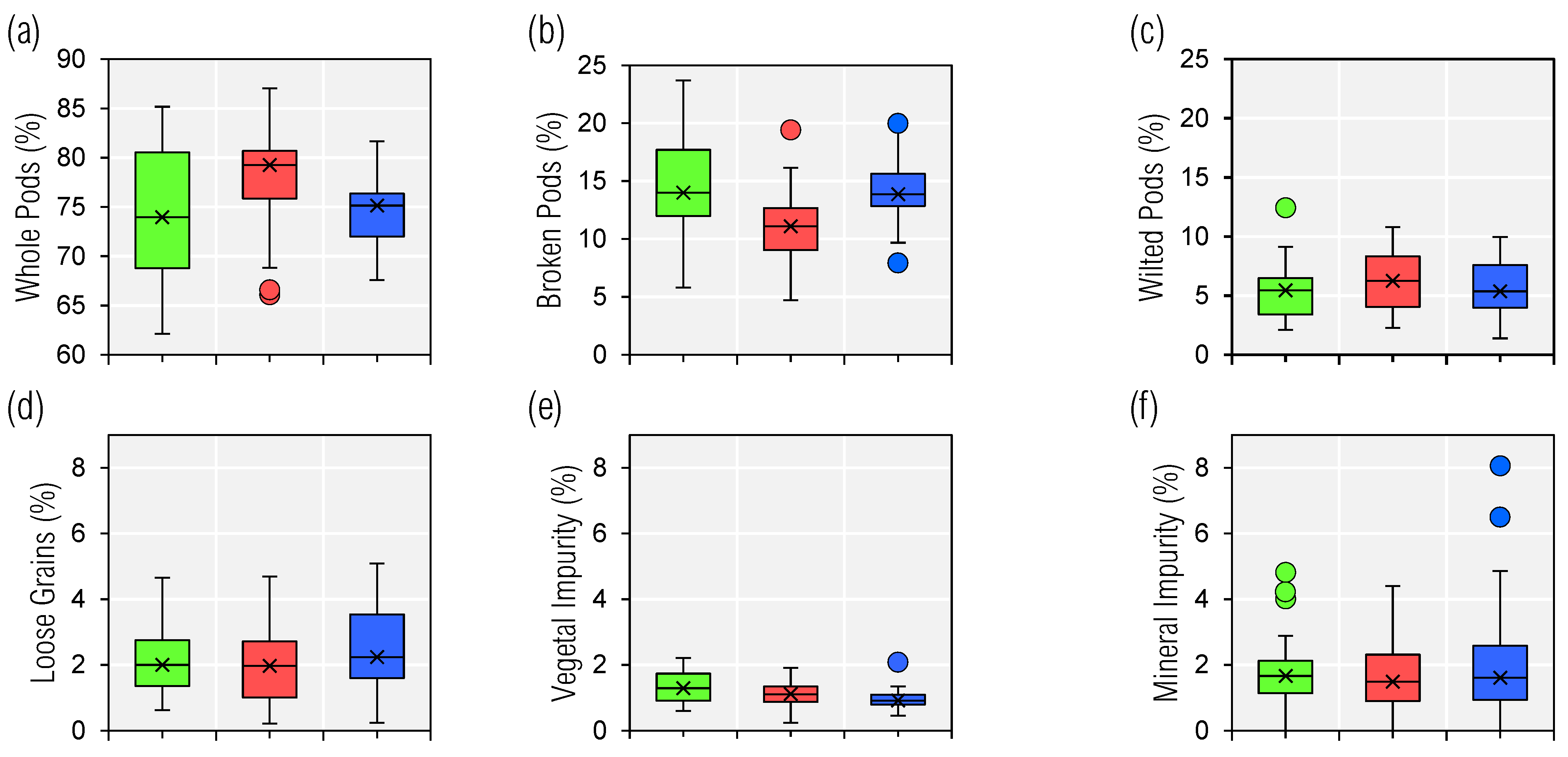
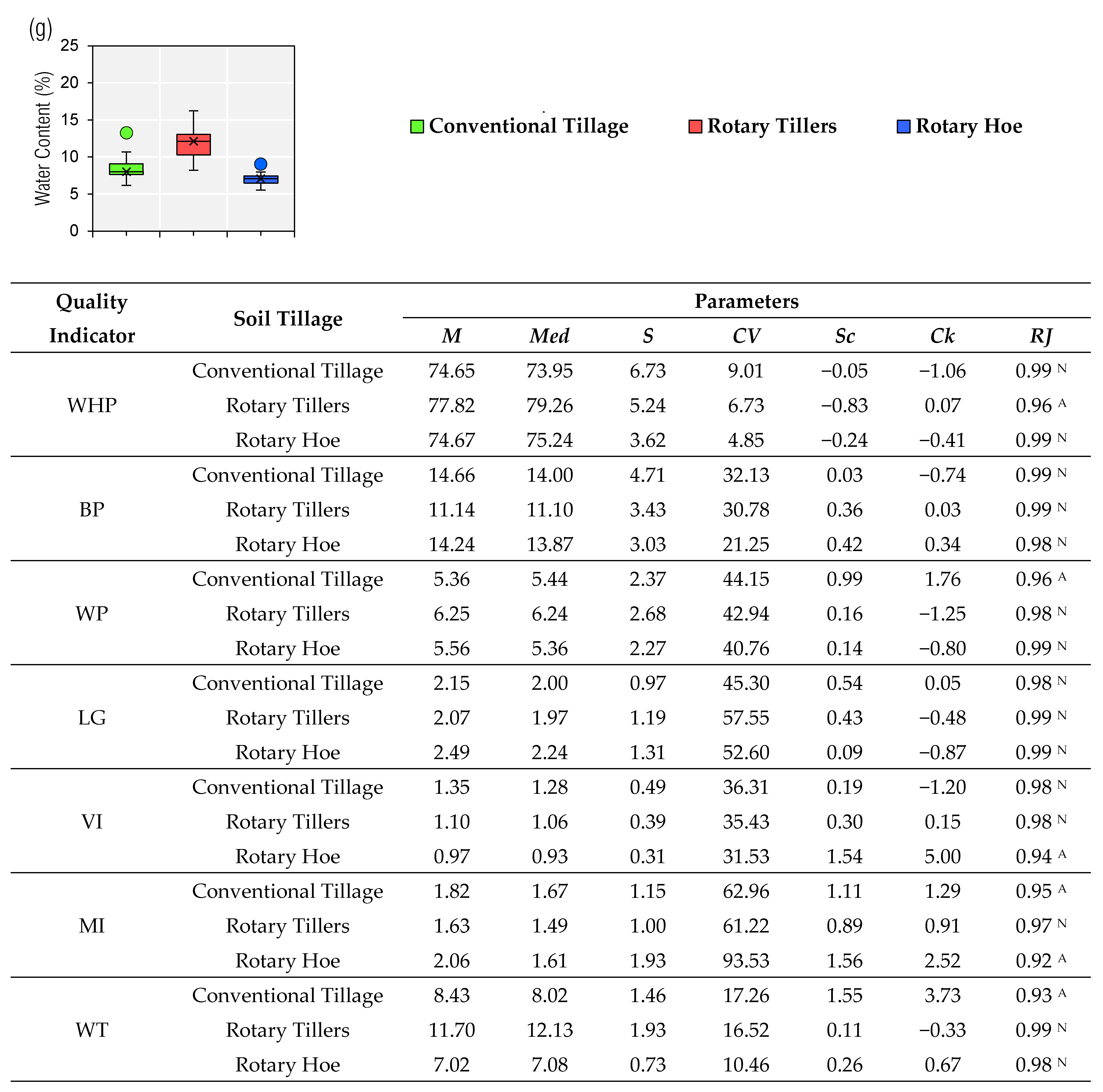
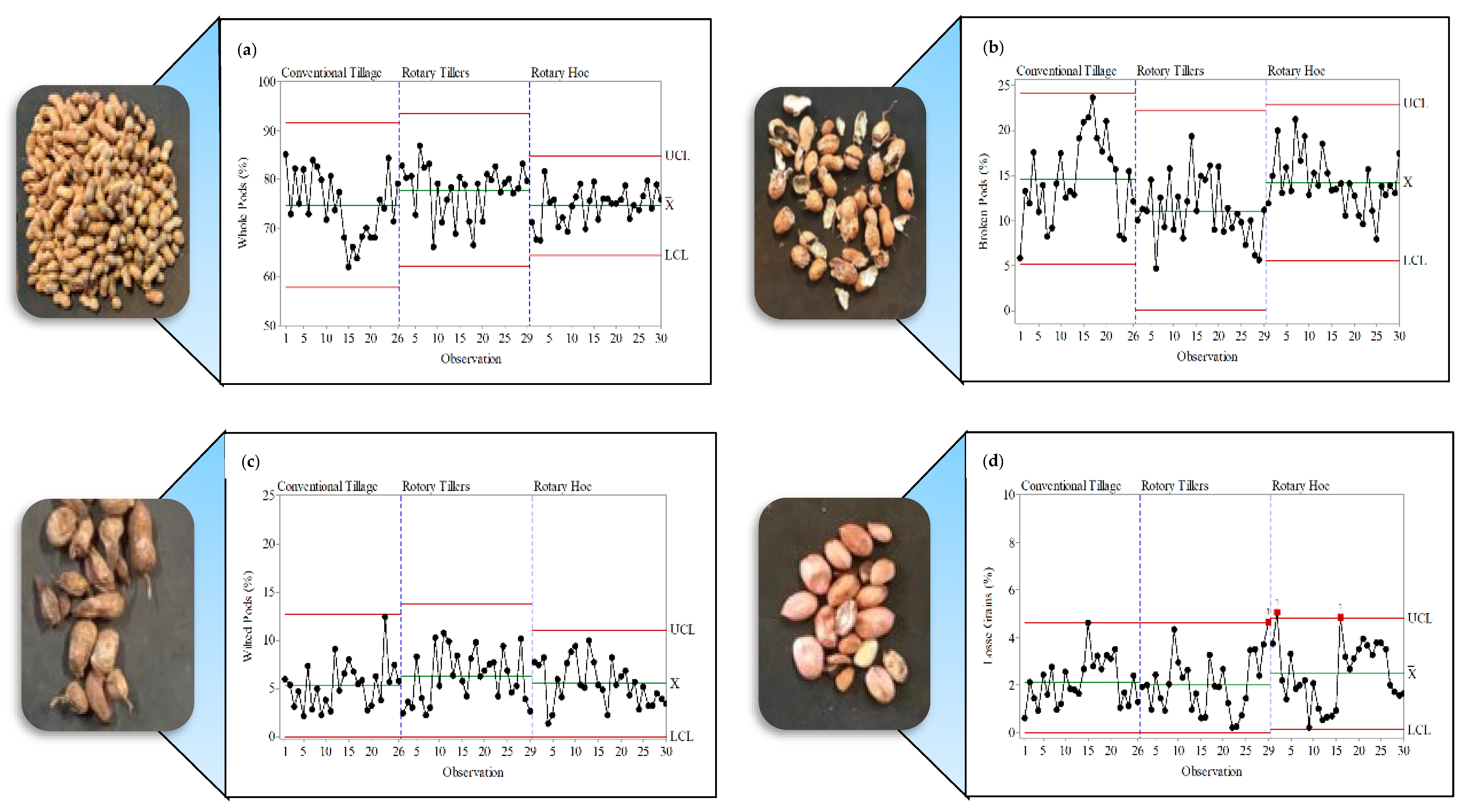

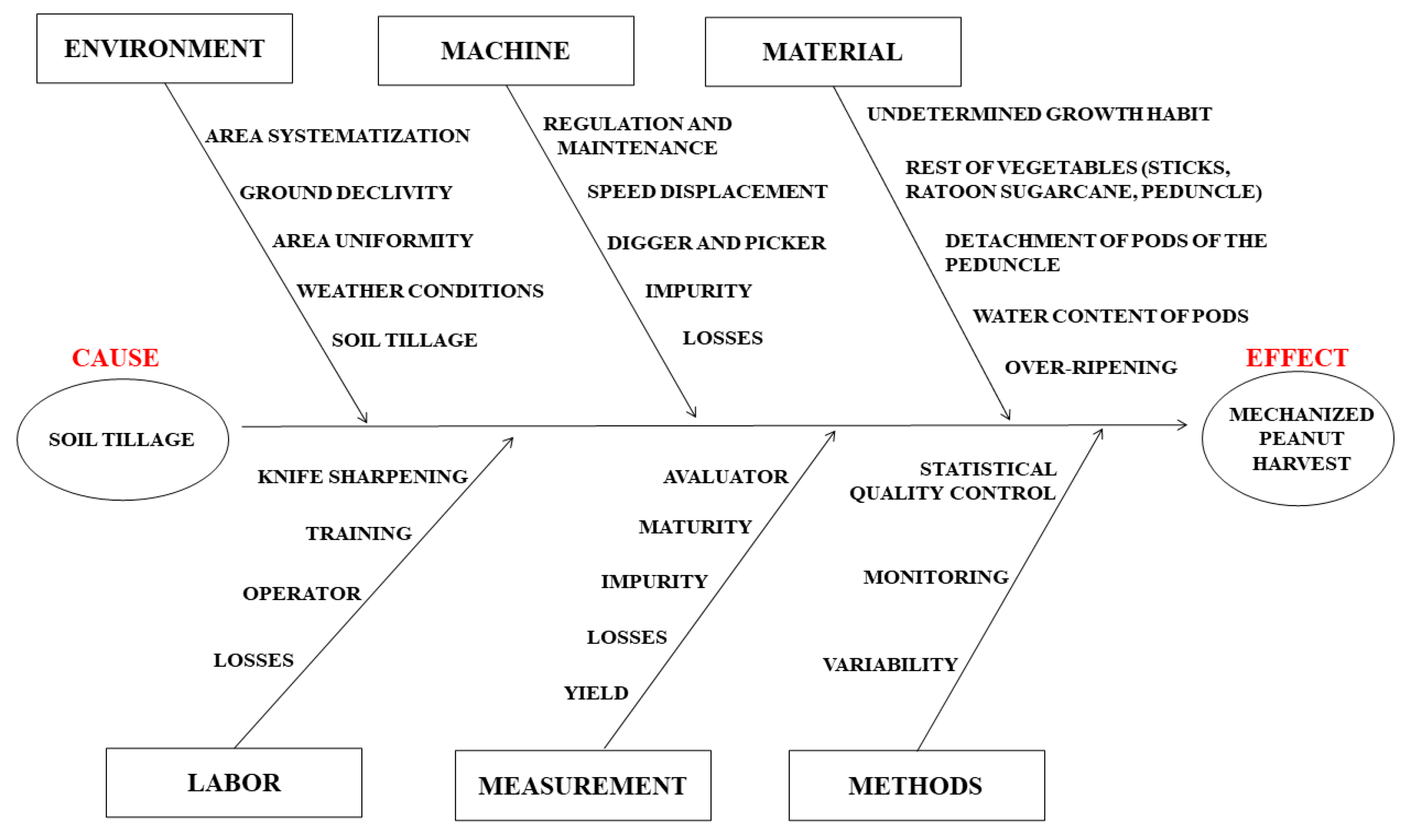
| Conventional Tillage | Rotary Tillers | Rotary Hoe |
|---|---|---|
| Ratoon Elimination | Ratoon Elimination | Ratoon Elimination |
| Subsoiling | Subsoiling | Subsoiling |
| Heavy Harrowing | Heavy Harrowing | Heavy Harrowing |
| Intermediate Harrowing | Intermediate Harrowing | Intermediate Harrowing |
| Light Harrowing | Light Harrowing | Light Harrowing |
| Rotary Tillers | Rotary Hoe |
| Equipment 1 | Working Width (m) | PTO Rotation 2 (rpm) | Number of Knives per Flange | Type of Knife |
|---|---|---|---|---|
| Rotary Tillers | 1.50 | 540 | 4 | Universal (“L”) |
| Rotary Hoe | 1.50 | 122 3 | 5 | Universal (“L”) |
| Image | Indicator | Description |
|---|---|---|
 | Whole pods | Pods without breaks and cracks. |
 | Broken pods | Broken, fragmented, or cracked pods. |
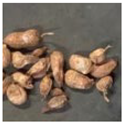 | Wilted pods | Pods formed, but which do not have mature grains or pods formed with smaller size and without grains. |
 | Loose grains | Loose or broken grains. |
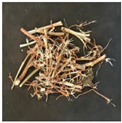 | Vegetal impurity | Branches, leaves, peduncles, and accent residues. |
 | Mineral impurity | Soil present in the sample in the form of earth and clods. |
| Quality Indicator | Soil Tillage | Parameters | |||
|---|---|---|---|---|---|
| 1C | M | T | O | ||
| WHP | Conventional Tillage | 0.344 ns | 0.656 ns | 0.926 ns | 0.074 ns |
| Rotary Tillers | 0.045 * | 0.955 ns | 0.966 ns | 0.034 * | |
| Rotary Hoe | 0.229 ns | 0.771 ns | 0.724 ns | 0.276 ns | |
| BP | Conventional Tillage | 0.023 * | 0.977 ns | 0.315 ns | 0.685 ns |
| Rotary Tillers | 0.830 ns | 0.170 ns | 0.997 ns | 0.003 * | |
| Rotary Hoe | 0.771 ns | 0.229 ns | 0.932 ns | 0.068 ns | |
| WP | Conventional Tillage | 0.115 ns | 0.885 ns | 0.973 ns | 0.027 * |
| Rotary Tillers | 0.427 ns | 0.573 ns | 0.325 ns | 0.675 ns | |
| Rotary Hoe | 0.069 ns | 0.931 ns | 0.383 ns | 0.617 ns | |
| LG | Conventional Tillage | 0.344 ns | 0.656 ns | 0.926 ns | 0.074 ns |
| Rotary Tillers | 0.094 ns | 0.906 ns | 0.181 ns | 0.819 ns | |
| Rotary Hoe | 0.001 * | 0.999 ns | 0.019* | 0.981 ns | |
| VI | Conventional Tillage | 0.055 ns | 0.945 ns | 0.027* | 0.973 ns |
| Rotary Tillers | 0.830 ns | 0.170 ns | 0.966 ns | 0.034 * | |
| Rotary Hoe | 0.355 ns | 0.645 ns | 0.932 ns | 0.068 ns | |
| MI | Conventional Tillage | 0.656 ns | 0.344 ns | 0.685 ns | 0.315 ns |
| Rotary Tillers | 0.045 * | 0.955 ns | 0.675 ns | 0.325 ns | |
| Rotary Hoe | 0.013 * | 0.987 ns | 0.117 ns | 0.883 ns | |
| WT | Conventional Tillage | 0.212 ns | 0.788 ns | 0.315 ns | 0.685 ns |
| Rotary Tillers1 | 0.094 ns | 0.906 ns | 0.181 ns | 0.819 ns | |
| Rotary Hoe | 0.069 ns | 0.931 ns | 0.001 * | 0.999 ns | |
Disclaimer/Publisher’s Note: The statements, opinions and data contained in all publications are solely those of the individual author(s) and contributor(s) and not of MDPI and/or the editor(s). MDPI and/or the editor(s) disclaim responsibility for any injury to people or property resulting from any ideas, methods, instructions or products referred to in the content. |
© 2023 by the authors. Licensee MDPI, Basel, Switzerland. This article is an open access article distributed under the terms and conditions of the Creative Commons Attribution (CC BY) license (https://creativecommons.org/licenses/by/4.0/).
Share and Cite
Lopes de Brito Filho, A.; Morlin Carneiro, F.; Costa Souza, J.B.; Luns Hatun de Almeida, S.; Patias Lena, B.; Pereira da Silva, R. Does the Soil Tillage Affect the Quality of the Peanut Picker? Agronomy 2023, 13, 1024. https://doi.org/10.3390/agronomy13041024
Lopes de Brito Filho A, Morlin Carneiro F, Costa Souza JB, Luns Hatun de Almeida S, Patias Lena B, Pereira da Silva R. Does the Soil Tillage Affect the Quality of the Peanut Picker? Agronomy. 2023; 13(4):1024. https://doi.org/10.3390/agronomy13041024
Chicago/Turabian StyleLopes de Brito Filho, Armando, Franciele Morlin Carneiro, Jarlyson Brunno Costa Souza, Samira Luns Hatun de Almeida, Bruno Patias Lena, and Rouverson Pereira da Silva. 2023. "Does the Soil Tillage Affect the Quality of the Peanut Picker?" Agronomy 13, no. 4: 1024. https://doi.org/10.3390/agronomy13041024
APA StyleLopes de Brito Filho, A., Morlin Carneiro, F., Costa Souza, J. B., Luns Hatun de Almeida, S., Patias Lena, B., & Pereira da Silva, R. (2023). Does the Soil Tillage Affect the Quality of the Peanut Picker? Agronomy, 13(4), 1024. https://doi.org/10.3390/agronomy13041024









